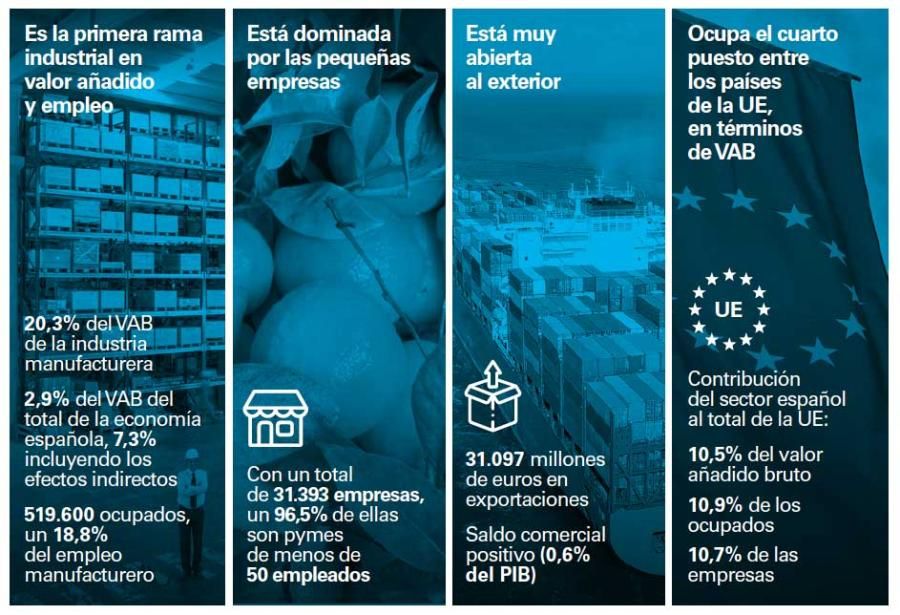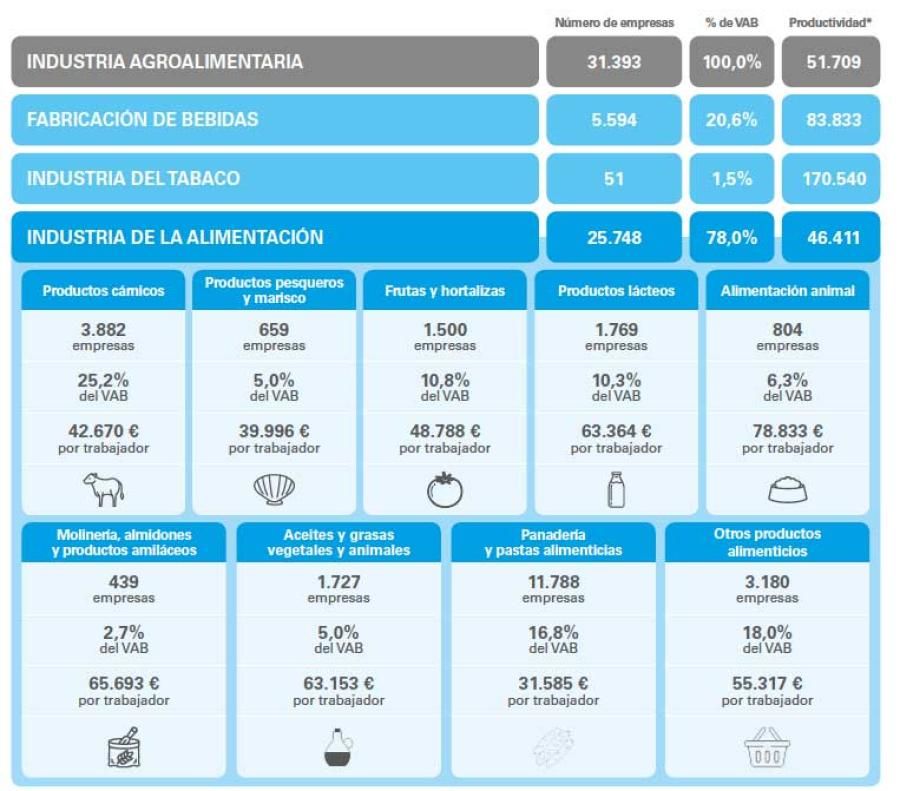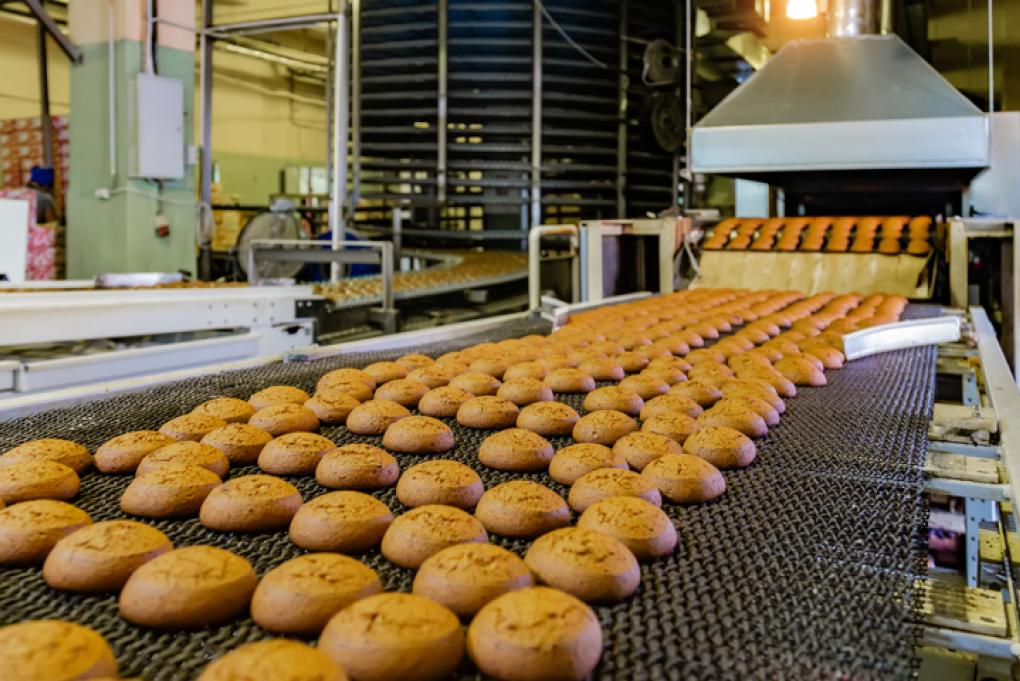
Spain’s agrifood industry: business structure and productivity
Agrifood is the main sector for Spanish industry. The sector has strong roots in Spain, generates stable employment and is very open to other markets. It also tends to have a highly fragmented business structure dominated by small firms and a few large companies that are less productive than their European counterparts. Increasing company size and boosting the productivity of larger firms through investment in R&D and adopting new technologies would help to improve the competitiveness of a key industry for the economy and society as a whole.
The agrifood industry1 makes a considerable contribution to economic activity, as shown by the key data on the sector: it contributes 2.9% towards the whole economy’s gross value added (GVA) and for the economy as a whole and 20.3% of the manufacturing industry’s GVA, making it the top ranking industrial sector for the Spanish economy. Spain ranks fourth among the countries that contribute the most to producing food and beverages at the European level (10.5% of the EU food and beverage industry’s GVA), after Germany, France and the United Kingdom, above countries such as Italy and the Netherlands2.
Moreover, employment in Spain’s agrifood industry has grown non-stop in the past six years, adding another 80,000 people since Q2 2013 and totalling 519,600 employees in Q2 2019, accounting for around 19% of manufacturing employment. With agrifood exports valued at more than EUR 31 billion, it helps to improve Spain’s trade balance thanks to a positive trade balance equivalent to 0.6% of GDP (cumulative data over 12 months up to June 2019).
- 1The agrifood industry is a subsector of the manufacturing industry and is made up of the food industry (NACE 10), the manufacture of beverages (NACE 11) and the tobacco industry (NACE 12). In addition to food fit for human consumption, it also includes the production of animal feed and the production of a number of intermediate products that are not directly food or food products (such as hides).
- 2Eurostat data (national accounts) corresponding to 2017, latest year available.
Leading industrial sector
Agrifood is the leading industrial sector in the Spanish economy. Spain is also the fourth largest contributor to food and beverage production in the European Union
Key figures for Spain’s agrifood industry

The industry also generates wealth, not only through its activity per se but it also indirectly benefits the rest of the economy thanks to its interrelation and knock-on effect on other sectors. These indirect effects occur due to the economic activity induced by purchases made in the agrifood industry from its suppliers. In order to meet this demand, in turn the suppliers increase their purchases from their own suppliers, which also generates value added. To calculate this indirect (or knockon) effect in the Spanish economy, the input-output tables are used which are estimated by the National Statistics Institute (the latest data being for 2015). We can therefore see that, for each EUR 100 of value added originating directly from the agrifood industry, the whole of the economy generates an additional EUR 153 indirectly, the highest «multiplier» among all branches of industry Logically, the products of agriculture, livestock farming and hunting are the main suppliers for the industry, followed by wholesale trade services and energy providers. However, other sectors which are apparently less closely related to the agrifood industry also benefit, such as legal and accounting services and chemical products. The direct and indirect contribution made by the agrifood industry is therefore equivalent to 7.3% of the GVA of the whole economy.
Major contributor to the state economy
The contribution made by the agrifood industry to the Spanish economy is very big, especially when the indirect effects are also taken into account: for every EUR 100 of value added originating directly from the agrifood industry, the economy generates an additional EUR 153 indirectly
The agrifood sector is firmly established within the region, as it is usually located close to the farms that supply its raw materials, which is then transformed into processed food products. The sector therefore employs local labour, contributing to the development of rural areas and social cohesion.
Also important is the fact that the sector generates relatively stable employment throughout the economic cycle, especially when compared with other sectors. If we look at the trend in employment and GVA in real terms during the most recent recessionary period (between 2007 and 2014) in relation to the total manufacturing sector, we can see that the annual decrease in real GVA was similar for both whereas job losses were considerably fewer in the agrifood industry. This phenomenon is also observed at European level, although the decline in employment was less pronounced in this case.
Employment in the agrifood industry is more stable
Annualised change in real GVA and employment between 2007 and 2014 (%)

Contributing to the development of rural areas and social cohesion
The agrifood sector is firmly rooted in the region, employs local labour (contributing to the development of rural areas and social cohesion) and generates more stable employment throughout the economic cycle
On analysing the composition of the agrifood sector, made up of the primary sector and the agrifood industry, we can see that the industrial component has been gaining weight, going from 37.2% in 2000 to 49.2% in 2017. In fact, Spain is one of the EU countries in which the industrial component has increased its share the most, indicating the notable growth and development of the agrifood industry over the past two decades. However, the relative weight of the industry in the agrifood sector as a whole remains below the EU average (56%) and below that of more industrialised economies such as Belgium, Ireland, the United Kingdom and Germany. In this respect, it would be advisable for the industry in Spain to focus more heavily on the transformation of agricultural products before they are sold on the domestic market or exported to increase the value added and differentiation of Spanish products on international markets.
Which European countries have the most industrialised agrifood sector?
Composition of the agrifood sector in GVA terms (%)

Looking to the future
A business strategy oriented towards the transformation of agricultural products would provide more added value and more differentiation in international markets
Tamaño de las empresas y subsectores
On the other hand, the agrifood industry has a highly fragmented business structure. Of the 31,393 firms that make up the sector, almost 80% are microenterprises with fewer than 10 employees, while companies with more than 250 employees do not reach 1% of the total. However, large companies contribute 42% of the agrifood industry’s GVA and employ 32% of its workers. Company size matters because it is directly related to the productivity of firms3.
Eurostat data on productivity by sector of activity and company size reveal the following features:
- Food companies4 are less productive than the manufacturing sector as a whole (–18.5%).
- Large food companies are 2.4 times more productive than microenterprises and 1.6 times more productive than medium-sized firms. This pattern of productivity growth with company size is also seen in the manufacturing sector and the EU as a whole.
- The productivity of Spain’s food industry is similar to that of the EU as a whole. However, there are significant differences depending on company size. On the one hand, Spanish SMEs (up to 250 employees) are more productive than their European counterparts, a significant fact since, for the manufacturing sector as a whole, Spanish SMEs are less productive than European ones. On the other hand, large food companies are less productive in Spain than in the EU as a whole, a fact also observed in the manufacturing industry.
Small firms dominate the agrifood industry but large companies employ more people and contribute more value added

Productivity of companies by their size in Spain and the EU
Gross value added per employee (thousand euros)

The agrifood industry is made up of several highly heterogeneous subsectors in terms of the number of companies, value added, employment and productivity. The meat industry and the manufacture of beverages lead the field in terms of value added while the manufacture of bakery products and pasta stands out for its large number of companies and employees. In fact, the highly labour-intensive nature of this subsector is reflected in its low labour productivity (32% below the agrifood industry average). At the other end of the scale is the tobacco industry, the beverage industry and the manufacture of animal feed products as the subsectors with the highest productivity.
Subsectors of the agrifood industry

Given this situation, the sector needs to implement a strategy to boost the growth of SMEs and help larger firms improve their productivity in order to close the productivity gap with its European counterparts.
Innovation, digitisation and the adoption of new technologies are emerging as key factors for the future of the agrifood industry5, especially as the sector is facing increasing challenges related to the efficient management of energy and natural resources, as well as adapting to consumers’ new dietary preferences.
- 5In this respect, the data on R&D investment in the sector are not very encouraging. According to the National Statistics Institute’s survey on company innovation, the innovative intensity of the agrifood industry is 0.57 compared with 0.89 for all companies and 1.23 for industry.



